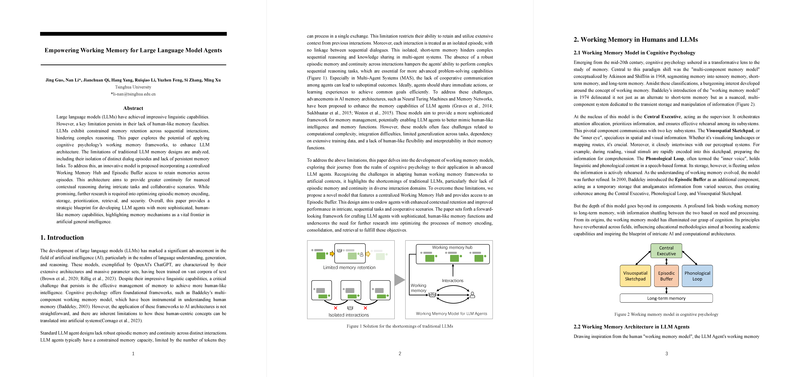The paper "Empowering Working Memory for LLM Agents" addresses the limitations of current LLM agents in maintaining memory continuity across sequential interactions, which hinders their ability to perform complex reasoning and collaborative tasks. The authors analyze the deficiencies in traditional LLM memory architectures, such as the isolation of dialog episodes and the lack of persistent memory links, and propose a novel model incorporating a centralized Working Memory Hub and Episodic Buffer access. This architecture aims to provide greater continuity for nuanced contextual reasoning during intricate tasks and collaborative scenarios.
The paper begins by discussing the advancements in AI, particularly in language understanding, generation, and reasoning, that have been made possible by LLMs. It identifies a critical challenge: enabling effective memory management to achieve more human-like intelligence. The authors draw on cognitive psychology, referencing Baddeley's multi-component working memory model, to provide a framework for understanding human memory. However, they acknowledge the difficulties in translating these human-centric concepts into artificial systems.
The paper critiques standard LLM agent designs, noting their constrained memory capacity, which is limited by the number of tokens they can process in a single exchange. It highlights that each interaction is treated as an isolated episode, which impedes complex sequential reasoning and knowledge sharing in Multi-Agent Systems (MAS). The authors also review existing AI memory architectures, such as Neural Turing Machines and Memory Networks, and point out their limitations, including computational complexity, integration challenges, and a lack of human-like flexibility and interpretability.
To overcome these limitations, the authors propose a novel model featuring a centralized Working Memory Hub and access to an Episodic Buffer. This design intends to equip agents with enhanced contextual retention and improved performance in intricate, sequential tasks and cooperative scenarios.
The paper describes the human working memory model, which includes the Central Executive, Visuospatial Sketchpad, Phonological Loop, and Episodic Buffer. The Central Executive orchestrates attention allocation, the Visuospatial Sketchpad specializes in spatial and visual information, the Phonological Loop holds linguistic and phonological content, and the Episodic Buffer integrates information from various sources. The authors then draw parallels between the human working memory model and the working memory architecture in LLM agents. They describe the Central Processor (the LLM itself), the External Environment Sensor, and the Interaction History Window. They note that the Interaction History Window has token limitations and that each interaction is treated as a distinct domain, lacking an episodic buffer.
To address these challenges, the authors propose an advanced working memory model for LLM agents, which includes a Working Memory Hub, Central Processor, External Environment Interface, Interaction History Window, and Episodic Buffer. The Working Memory Hub acts as the centralized data exchange for the entire architecture, routing all inputs, outputs, and histories between components. The Episodic Buffer provides a long-term episodic memory capacity, preserving entire interaction episodes as distinct memory traces.
The authors discuss the use of third-party databases as external memory repositories, highlighting the importance of storage format. They note that natural language storage is well-suited for keyword-based searches, while embeddings streamline retrieval through vector representations. They suggest using both natural language and embeddings concurrently to capitalize on their complementary strengths. They also discuss platforms such as Xata, a PaaS (Platform as a Service), as a robust solution for managing memory in MAS.
The paper further explores memory access mechanisms in LLM MAS, including role-based memory access, task-based memory access, autonomous memory access, collaboration scenario-based memory access, and memory management agents. Role-based memory access assigns memory access rights based on an agent's role, while task-based memory access ties memory access to the specific task an agent is assigned. Autonomous memory access allows agents to self-determine which memory segments they need, and collaboration scenario-based memory access varies based on the nature of collaboration. A Memory Management Agent manages, sorts, and retrieves relevant portions of historical data.
The paper discusses strategies to improve memory retrieval efficiency in Multi-Agent Systems, including SQL (Structured Query Language) search, full-text search, and semantic search (vector search). SQL search allows for precise data retrieval based on specific criteria, full-text search scans through entire textual datasets to locate specific sequences, and semantic search enables agents to understand and fetch information based on the underlying intent or meaning. The authors conclude that a multifaceted approach, harnessing the capabilities of all three search methods, is necessary for a sophisticated and adaptive memory retrieval mechanism.
In conclusion, the paper proposes a strategic blueprint for developing LLM agents with more robust and human-like memory capabilities. The authors identify limitations in current LLM agent models and propose an enhanced model incorporating a centralized Working Memory Hub and Episodic Buffer access. They emphasize that further advancements in memory encoding, consolidation, and retrieval mechanisms are imperative to fully realize these ambitions. They also note the need for more precise mechanisms for determining memory relevance, addressing security vulnerabilities, and developing methods to compress episodic memories for storage.
